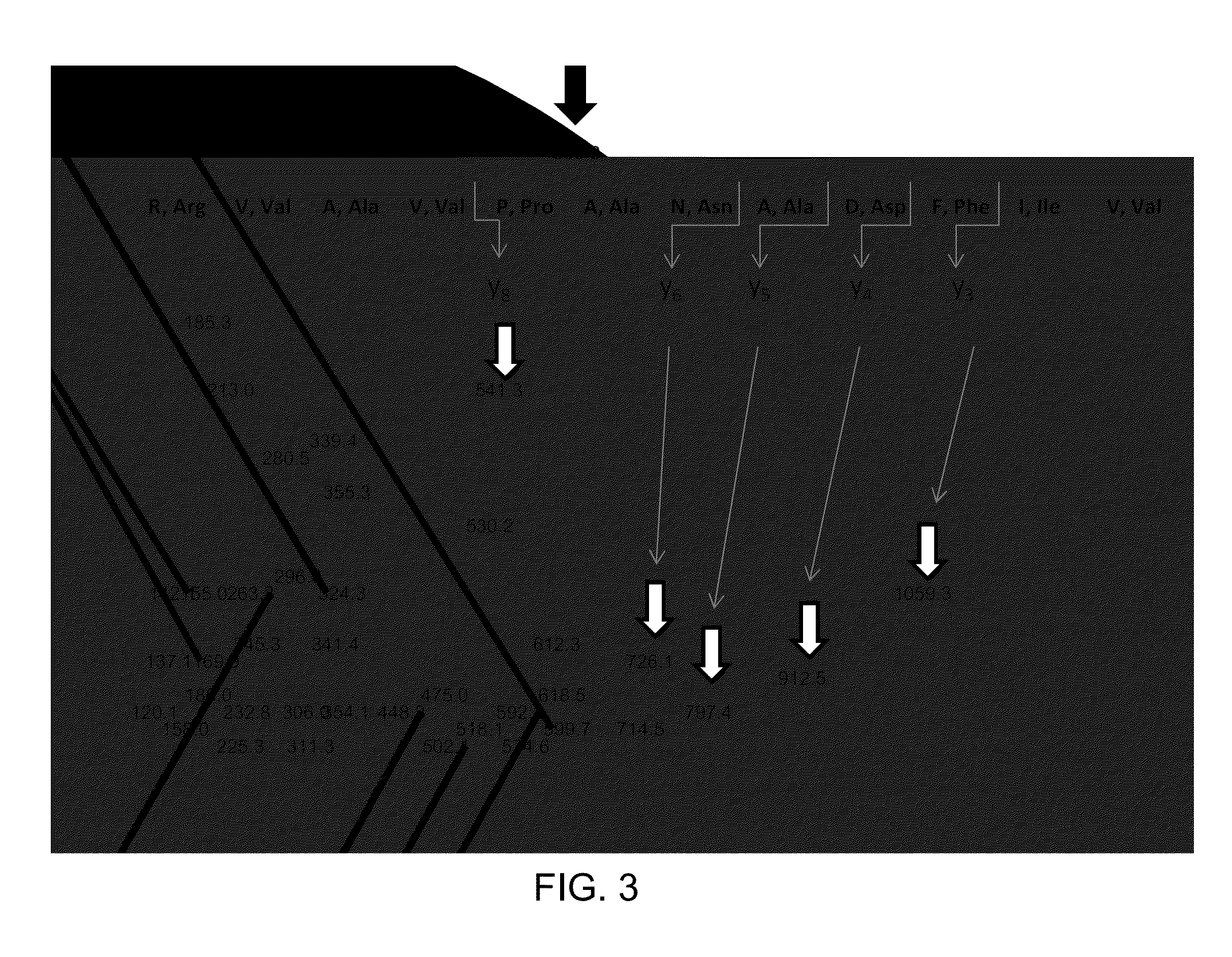Methods for analysis of free and autoantibody-bound biomarkers and associated compositions, devices, and systems
a technology of autoantibody and biomarker, applied in the analysis of chemical indicators, laboratory glassware, instruments, etc., can solve the problems of affecting the assay used to detect the biomarker, the individual can be improperly treated for a condition, and the detection of a biomarker is problematic, so as to achieve high mass resolution and high mass accuracy
- Summary
- Abstract
- Description
- Claims
- Application Information
AI Technical Summary
Benefits of technology
Problems solved by technology
Method used
Image
Examples
example 1
Preparation of Reagents, Standards, and Quality Control Samples
[0079]Standard of human Tg is purchased from AbD Serotec (Oxford, UK); stock solution of Tg is prepared at 1 mg / mL in 0.1% BSA, aliquoted in micro centrifuge tubes and stored at −70° C. Calibration standards of Tg are purchased from Beckman Coulter (Fullerton, Calif.); Tg concentrations in the standards are 0, 0.6, 6, 60, 150 ng / mL (0, 0.91, 9.1, 91 and 227 pmol / L). Rabbit polyclonal anti-Tg antibody is purchased from Covance (Princeton, N.J.) and diluted to 60 ng / μL with 0.1% BSA. Serum quality control samples are pooled human serum samples and contain 2, 6.5, and 170 ng / mL (3, 9.8, 258 pmol / L) of Tg. Working internal standard (IS) of “winged” peptide, sequence PVPESKVIFDANAPV*AVRSKVPDS (V* [13C5; 15N] (SEQ ID 005); mass shift 6 Da, RS synthesis Louisville, Ky.) is prepared at a concentration of 10 pg / μL (3.95 fmol / μL) in 20% acetonitrile in water.
[0080]Trypsin, formic acid (FA), dithiothreitol (DTT) and sodium deoxycho...
example 2
Conjugation of Antibody to Magnetic Beads
[0081]Custom polyclonal rabbit anti-peptide antibody (Covance, Princeton, N.J.) is conjugated to Tosyl activated magnetic beads (DynaBeads M280, Life Technologies, Carlsbad, Calif.) according to the manufacturer's recommendations. Briefly, the beads are washed with PBS (pH 7.4) and re-suspended in a 1M ammonium sulfate solution containing 20 μg of antibody per milligram of beads. Beads are incubated at 37° C. for 20 hours, washed and incubated for 1 hour with blocking buffer containing 0.5% BSA for one hour and reconstituted to a concentration of 20 μg / μL. Antibody content on the beads is approximately 0.2 μg / μL.
example 3
Trypsin Digestion Followed by Immunoaffinity Capture
[0082]Sample preparation is performed on a liquid handler (epMotion, Eppendorf, Hamburg, Germany). 5 μL (60 ng / μL) of rabbit anti-Tg antibody is added to a 500 μL aliquot of serum or plasma sample and the samples are incubated for one hour with mixing at 20° C. After the incubation, 350 μL of saturated ammonium sulfate solution is added to the samples, and Tg is precipitated along with immunoglobulins (IG). The samples are vortex-mixed for 10 min, centrifuged for 5 min at 15000 g, and the supernatants are discarded. The precipitates are reconstituted with 300 μL of water, 10 μL of internal standard (IS), 10 μL of 20 mM dithiothreitol, and 30 μL of 5% sodium deoxycholate are added, after which the samples are incubated at 60° C. for 30 min. After the incubation, 400 μL of 25 mM ammonium bicarbonate and 10 μL of trypsin (4 μg / μL) are added to the samples, and the samples are incubated for 4 hours at 37° C.
[0083]Magnetic beads are pro...
PUM
| Property | Measurement | Unit |
|---|---|---|
| concentrations | aaaaa | aaaaa |
| concentrations | aaaaa | aaaaa |
| concentrations | aaaaa | aaaaa |
Abstract
Description
Claims
Application Information
 Login to View More
Login to View More - R&D
- Intellectual Property
- Life Sciences
- Materials
- Tech Scout
- Unparalleled Data Quality
- Higher Quality Content
- 60% Fewer Hallucinations
Browse by: Latest US Patents, China's latest patents, Technical Efficacy Thesaurus, Application Domain, Technology Topic, Popular Technical Reports.
© 2025 PatSnap. All rights reserved.Legal|Privacy policy|Modern Slavery Act Transparency Statement|Sitemap|About US| Contact US: help@patsnap.com



